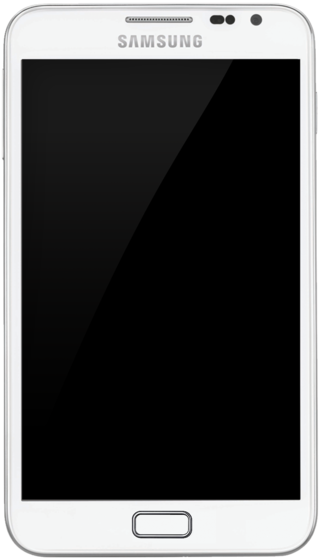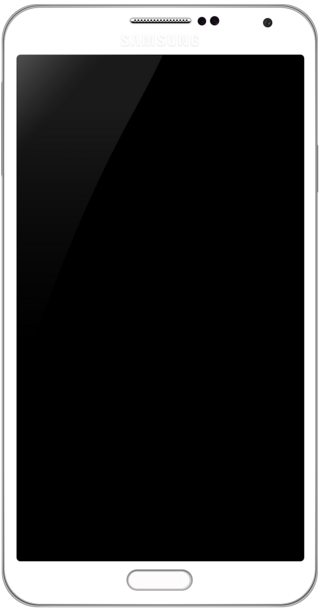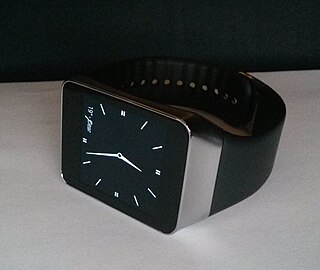
Samsung Galaxy is a series of computing and mobile computing devices that are designed, manufactured and marketed by Samsung Electronics. The product line includes the Samsung Samsung Galaxy S series of high-end phones, Samsung Galaxy Z series of high-end foldables, Samsung Galaxy A series of Mid-range phones, the Samsung Galaxy Book, the Samsung Samsung Galaxy Tab series, the Samsung Galaxy Watch, the Samsung Samsung Galaxy Buds series and the Samsung Samsung Galaxy Fit.

A smartwatch is a portable and wearable computer device in a form of a watch; modern smartwatches provide a local touchscreen interface for daily use, while an associated smartphone app provides management and telemetry, such as long-term biomonitoring. While early models could perform basic tasks such as calculations, digital time telling, translations, and game-playing, smartwatches released since 2015 have more general functionality closer to smartphones, including mobile apps, a mobile operating system, and WiFi/Bluetooth connectivity. Some smartwatches function as portable media players, with FM radio and playback of digital audio and video files via a Bluetooth headset. Some models, called watch phones, have mobile cellular functionality such as making telephone calls.

The Samsung Galaxy Note is an Android smartphone produced by Samsung Electronics. It was unveiled at IFA Berlin 2011 and first released in Germany in late October 2011, with other countries following afterwards. The Galaxy Note was distinguished by its unusually large form factor—later referred to using the term "phablet"—which straddled the size of the average smartphone at the time, and that of a small tablet: it features a 5.3-inch display, and is bundled with a stylus branded as the "S Pen", which can be used to navigate the device's user interface, and write or draw in supported apps.

Tizen is a Linux-based mobile operating system backed by the Linux Foundation, developed and used primarily by Samsung Electronics.

The Sony SmartWatch is a line of wearable devices developed and marketed by Sony Mobile from 2012 to 2016 through three generations. They connect to Android smartphones and can display information such as Twitter feeds and SMS messages, among other things.

The Samsung Galaxy S4 is an Android smartphone produced by Samsung Electronics as the fourth smartphone of the Samsung Galaxy S series and was first shown publicly on March 14, 2013, at Samsung Mobile Unpacked in New York City. It is the successor to the Galaxy S III, which maintains a similar design, but with upgraded hardware, more sensors, and an increased focus on software features that take advantage of its hardware capabilities—such as the ability to detect when a finger is hovered over the screen, and expanded eye tracking functionality, it was released the previous year. A hardware variant of the S4 became the first smartphone to support the emerging LTE Advanced mobile network standard. The T-Mobile version of the Galaxy S4, named the model (SGH-M919), was released the same month. The phone's successor, the Samsung Galaxy S5, was released the next year.

The Samsung Galaxy Note 3 is an Android phablet smartphone produced by Samsung Electronics as part of the Samsung Galaxy Note series. The Galaxy Note 3 was unveiled on September 4, 2013, with its worldwide release beginning later in the month. Serving as a successor to the Galaxy Note II, the Note 3 was designed to have a lighter, more upscale design than previous iterations of the Galaxy Note series, and to expand upon the stylus and multitasking-oriented functionality in its software—which includes a new pie menu opened through the button on the stylus for quick access to pen-enabled apps, along with pop-up apps and expanded multi-window functionality. It additionally features new sensors, a USB 3.0 port, 3 GB of RAM, and its video camera has been upgraded to 2160p (4K) resolution and doubled framerate of 60 at 1080p, placing it among the earliest smartphones to be equipped with any of these.

The Samsung Galaxy Gear is a smartwatch produced by Samsung Electronics in the Samsung Gear family of devices. Unveiled during a Samsung Unpacked event in Berlin, Germany on September 4, 2013, the device serves as a companion for all Samsung Galaxy smartphones and tablets which runs on Android 4.3 "Jelly Bean" or newer. It was released on September 25, 2013. Originally released as an Android-based device, Samsung replaced the operating system with Tizen through the May 2014 software update.

The Samsung Galaxy S5 is an Android-based smartphone unveiled, produced, released and marketed by Samsung Electronics as part of the Samsung Galaxy S series. Unveiled on 24 February 2014 at Mobile World Congress in Barcelona, Spain, it was released on 11 April 2014 in 150 countries as the immediate successor to the Galaxy S4. As with the S4, the S5 is an evolution of the prior year's model, placing a particular emphasis on an improved build with a textured rear cover, IP67 certification for dust and water resistance, a more refined user experience, new security features such as a fingerprint reader and private mode, expanded health-related features including a built-in heart rate monitor, a USB 3.0 port, and an updated camera featuring speedy auto-focus through phase-detection. The video resolution has been upgraded to 2160p (4K) and the frame rate at 1080p has been doubled to 60 for a smooth appearance.

Samsung Gear is a line of wearable computing devices produced by Samsung Electronics. The first device in the series, the Samsung Galaxy Gear smartwatch, was announced in 2013. Since then, the line has expanded to include fitness bands and earbuds, as well as more smartwatches.

The Samsung Galaxy Note 3 Neo is an Android phablet smartphone produced by Samsung Electronics. The Galaxy Note 3 Neo was unveiled by Samsung Poland on February 1, 2014, with its worldwide release later in that month. Serving as a lower priced version of the Samsung Galaxy Note 3, the Note 3 Neo was designed to have the same lighter, more upscale design than previous iterations of the Galaxy series first supported by its bigger sibling, and to expand upon the stylus and multi-tasking oriented functionality in its software, which includes the new navigation wheel for pen-enabled apps, along with pop-up apps and expanded multi-window functionality, while lacking more sophisticated functionality such as 1080p video recording and USB 2.0 port.

Wear OS is a version of Google's Android operating system designed for smartwatches and other wearables. By pairing with mobile phones running Android version 6.0 "Marshmallow" or newer, or iOS version 10.0 or newer with limited support from Google's pairing application, Wear OS integrates Google Assistant technology and mobile notifications into a smartwatch form factor. Wear OS is closed-source, in contrast to the free and open-source Android.

The LG G Watch is an Android Wear-based smartwatch announced and released by LG and Google on June 25, 2014. It was released along with the Samsung Gear Live as launch devices for Android Wear, a modified version of Android designed specifically for smartwatches and other wearables. It is compatible with all smartphones running Android 4.3 or higher that support Bluetooth LE.

The Samsung Gear Live is an Android Wear-based smartwatch announced and released by Samsung and Google on June 25, 2014. It was released along with the LG G Watch as launch devices for Android Wear, a modified version of Android designed specifically for smartwatches and other wearables. Gear Live is the 5th device launched in the Samsung Gear family of wearables. It is compatible with all smartphones running Android 4.3 or higher that support Bluetooth Smart.

The Samsung Galaxy Alpha (SM-G850x) is an Android smartphone produced by Samsung Electronics. Unveiled on 13 August 2014, the device was released in September 2014. A high-end device, the Galaxy Alpha is Samsung's first Android-powered smartphone to incorporate a metallic frame, although the remainder of its physical appearance still resembles previous models such as the Galaxy S5. It also incorporates Samsung's new Exynos 5430 system-on-chip, which is the first mobile system-on-chip to use a 20 nanometer manufacturing process.

The Samsung Gear S2 is a smartwatch developed by Samsung Electronics running Samsung's Tizen operating system. It was unveiled at IFA in 2015.

An always-on display (AOD) is a smartphone feature that has the device continue to show limited information while the phone is asleep. It is widely available on Android handsets, and is available on Apple iPhones since the iPhone 14 Pro. On some Android devices, the feature is sometimes called Ambient Display or Active Display, depending on its implementation and behavior. Depending on the phone's design, it may be a replacement or complementary to another feature, such as the notification LED.

The Samsung Galaxy S9 and S9+ are Android-based smartphones unveiled, manufactured, released and marketed by Samsung Electronics as part of the Samsung Galaxy S series. The devices were revealed at the Mobile World Congress in Barcelona on 25 February 2018, as the successors to the Samsung Galaxy S8 and S8+.

The Samsung Galaxy Watch 4 is a smartwatch developed by Samsung Electronics. It is the first Samsung watch to run Google's Wear OS since the Samsung Gear Live, and the first watch to run Wear OS 3, co-developed by Samsung and Google. The device largely followed the design language of the preceding Samsung Galaxy Watch Active and Galaxy Watch 3, but including all new software. The watch also included EKG, body compositional analysis, and blood pressure monitoring via the new Samsung BioActive sensor. It was announced on August 11, 2021, at Samsung's Unpacked Event alongside the Samsung Galaxy Z Flip 3, Samsung Galaxy Z Fold 3 and Galaxy Buds 2. The watch was released worldwide on August 27, 2021.

The Pixel Watch is a Wear OS smartwatch designed, developed, and marketed by Google as part of the Google Pixel product line. First previewed in May 2022 during the Google I/O keynote, it features a round dome-shaped display as well as deep integration with Fitbit, which Google acquired in 2021. Two Pixel-branded smartwatches had been in development at Google by July 2016, but were canceled ahead of their release due to hardware chief Rick Osterloh's concerns that they did not fit well with other Pixel devices. Development on a new Pixel-branded watch began shortly after Google's acquisition of Fitbit.


















